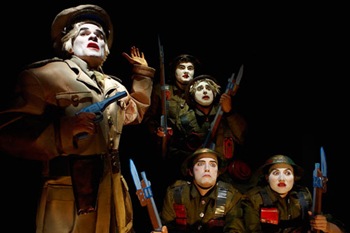By George Perry
The Great War is a not-to-be-missed barrage of entertainment and enlightenment on the Toronto stage
The Great War The History of the Village of the Small Huts – 1914-1918 is one of the plays in VideoCabaret’s The History of the Village Of The Small Huts series. Written and directed by Michael Hollingsworth, The Great War was originally produced in 1993.
It is currently playing at The Cameron House for a limited run. The Cameron is a cozy space on Queen Street, just west of Spadina. Look for the building with giant ants crawling on its side if approaching from the east.
Two rooms comprise the venue. The first that one enters is a fairly typical downtown bar, with funky chairs and sofas scattered about. Gallery worthy art adorns the walls. There’s also a stage for bands.
Walking through the red curtains and thin corridor, it feels like you’re one of the outdoor ants. The brief trenching is well worth it. The back room is a 50 seat theatre, an oasis created by VideoCab in 2000. Seats, tables and friends beckon.
We were briefed on the nuances of the theatre. VideoCab president Suzanne DePoe engaged the audience in some brief small talk. Sadly, we all learned that the Montreal Canadiens were behind in the big hockey game.
The magic of the “black box” stage shines when absolute darkness descends. The makeup and costumes of the actors seem sublime, surreal, other-worldly.
The characters are both grotesque and familiar. The definition and clarity is mind-boggling. We couldn’t believe our eyes through most of the performance, thinking our drinks may have been spiked. We meet 40 characters, superbly played by 7 hugely talented actors.
The play is two 50-minute acts. Each act is comprised of dozens of short skits. After each skit, total darkness briefly washes our senses. Then, a new set and new characters appear in the “black box”.
A tank will be on stage one minute, and the next minute it is gone. It is replaced by a train or a World War I trench. It is no wonder that this play has won VideoCabaret so many Dora Awards.
Prime Minister Borden appears in the first skit playing golf. His club is like a child’s toy, oversized and extremely colourful. The colours of all these toys are hyper-real, psychedelic.
This is a common metaphor throughout the play. The Canadian soldiers have colourful toys instead of rifles. The infirmed have oversized bottles of cognac. The British treat the glorious Canadian soldiers as if they are disposable toys.
Sound too was sparkling. The mood (the “trip”) was enhanced through sound use. Effects during a roll call confirming another Canadian slaughter was very effective. So was the sound when helmets were introduced to the soldiers.
The “black box”, makeup and costumes all challenged our minds. An actor playing a character at the back of the stage in one scene might appear four feet tall. In the next, he might appear to be seven feet tall.
Some of the makeup reminded us of some of the Batman films. Colonel Otto Schlippenschloppen bore an uncanny resemblance to Jack Nicholson’s Joker.
The oversized army uniforms reminded us of David Byrne’s oversized suit from the Talking Heads’ rockumentary Stop Making Sense.
Naturally, the Marx Brothers’ 1933 classic film Duck Soup was also recalled.
As short as the skits are, we do develop an attachment to some characters. One is Dave. He is a simple farm boy at the beginning of the play. Unable to slaughter a chicken for dinner, he has given it a name instead.
By Armistice Day, Dave is unable to stop shooting human beings. He is no longer able to tell the difference between a raccoon and a German. Were those trout flopping around or his fellow soldiers after a gas attack?
As the seconds tick down to 11:00, Dave is shooting at everything he can. He has become the prototype for lone gunmen across college campuses everywhere. He wants to return home and raise harmless rabbits. He is silenced when he is killed. He has come full circle.
Canadian troops as a whole have matured and come full circle. They land in Ypres and are slaughtered. As a reward, the British insist that their toys march 80 miles in 20 hours, so as to endure another slaughter. The Canadian “toys” are further slaughtered in the Somme and Vimy Ridge. They return to where they started: Ypres – only now, it is named Passchendaele.
In the final skit, Borden is playing golf again. The formerly gung-ho Prime Minister now seeks Confederacy. Borden too has matured and come full circle.
We left The Cameron with a much greater appreciation for Canada’s contribution to The Great War. In two hours, VideoCab taught us more about Canadian sacrifices than years of Canadian high school did.
Our teachers said, “Just know the names, Ypers, Vimy, etc. Mustard gas.” We were Radar O’Reily being told to say “ahhh, Bach” in that classic M*A*S*H episode.
Most of us bought it, though. Then we had our minds blown by this production. VideoCab reminds us that 58,000 Canadians were killed in The Great War. Another 230,000 were injured. It only took a 100 minute VideoCab “trip” to remind us.
Details:
– Performances take place at The Cameron House, 408 Queen W.
– Opens May 6 and runs to Jun 30, Tue-Sat 8 pm, Sun 2:30 pm
– Tickets cost $15-$30, available in person or call 416-703-1725
— www.videocab.com
Photo of Richard Clarkin, Dylan Roberts, Anand Rajaram, Mac Fyfe and Kerry Ann Doherty by Michael Cooper

